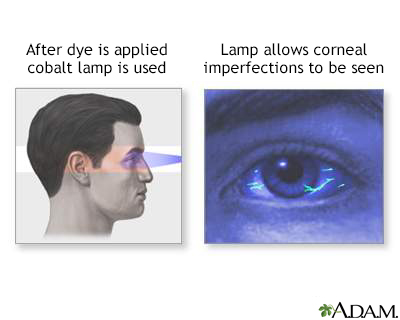
This is a test that uses orange dye (fluorescein) and a blue light to detect foreign bodies in the eye. This test can also detect damage to the cornea. The cornea is the outer surface of the eye.

A piece of blotting paper containing the dye is touched to the surface of your eye. Sometimes the dye comes in a drop form which also contains anesthetic. You are asked to blink. Blinking spreads the dye and coats the tear film covering the surface of the cornea. The tear film contains water, oil, and mucus to protect and lubricate the eye.
The health care provider then shines a blue light at your eye. Any problems on the surface of the cornea will be stained by the dye and appear green under the blue light.
The provider can determine the location and likely cause of the cornea problem depending on the size, location, and shape of the staining.
You will need to remove your eyeglasses or contact lenses before the test.
If your eyes are very dry, the blotting paper may be slightly scratchy. The dye may cause a mild and brief stinging sensation if there is no anesthetic used.
This test is to:
If the test result is normal, the dye remains in the tear film on the surface of the eye but does not show any abnormal areas.
Abnormal results may point to:
Often the test is done to check for any of the conditions listed above.
If the dye touches the skin, there may be a slight, brief, discoloration. It may stain your clothing or other fabric.
Fowler GC. Corneal abrasions and removal of corneal or conjunctival foreign bodies. In: Fowler GC, ed. Pfenninger and Fowler's Procedures for Primary Care. 4th ed. Philadelphia, PA: Elsevier; 2020:chap 200.
Knoop KJ, Dennis WR. Ophthalmologic procedures. In: Roberts JR, Custalow CB, Thomsen TW, eds. Roberts and Hedges' Clinical Procedures in Emergency Medicine and Acute Care. 7th ed. Philadelphia, PA: Elsevier; 2019:chap 62.
Sall K, Foulks GN, Pucker AD, Ice KL, Zink RC, Magrath G. Validation of a modified national eye institute grading scale for corneal fluorescein staining. Clin Ophthalmol. 2023;17:757-767. PMID: 36915716 pubmed.ncbi.nlm.nih.gov/36915716/.
BACK TO TOPReview Date: 1/20/2025
Reviewed By: Franklin W. Lusby, MD, Ophthalmologist, Lusby Vision Institute, La Jolla, CA. Also reviewed by David C. Dugdale, MD, Medical Director, Brenda Conaway, Editorial Director, and the A.D.A.M. Editorial team.

|
A.D.A.M., Inc. is accredited by URAC, also known as the American Accreditation HealthCare Commission (www.urac.org). URAC's accreditation program is an independent audit to verify that A.D.A.M. follows rigorous standards of quality and accountability. A.D.A.M. is among the first to achieve this important distinction for online health information and services. Learn more about A.D.A.M.'s editorial policy, editorial process and privacy policy. A.D.A.M. is also a founding member of Hi-Ethics and subscribes to the principles of the Health on the Net Foundation (www.hon.ch). |
The information provided herein should not be used during any medical emergency or for the diagnosis or treatment of any medical condition. A licensed medical professional should be consulted for diagnosis and treatment of any and all medical conditions. Call 911 for all medical emergencies. Links to other sites are provided for information only -- they do not constitute endorsements of those other sites. © 1997- A.D.A.M., Inc. Any duplication or distribution of the information contained herein is strictly prohibited.